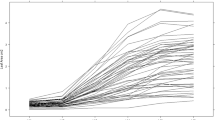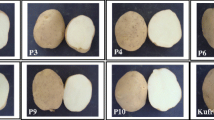Abstract
Four different sets of true potato seed (TPS) families, representing a total of 262 hybrids derived from intermating tetraploid clones were evaluated in three different locations in Peru. Significant differences were observed among families in tuber yield, uniformity and transplant survival rate in the field. Several families produced an average tuber yield of more than 1.0 kg per plant, with a tuber uniformity of some families approaching that of standard varieties. Hybrid TPS families gave higher tuber yields and more uniform tubers than families from open-pollination. On the basis of an observed family-environment interaction for tuber yield, it is suggested that locally adapted cultivars or advanced selections should be used as parents to generate TPS progenies for specific areas.
Resumen
Cuatro grupos diferentes de familias de semilla botánica de papa representando un total de 262 híbridos derivados de cruzas entre clones tetraploides fueron evaluados en tres localidades diferentes en Perú. Se observo diferencias significativas entre familias para rendimiento de tubérculos, uniformidad y porcentaje de supervivencia de las plantulas en el campo. Varias familias produjeron un rendimiento promedio de tubérculos mayor a 1 kg por planta. Ademas, los tubérculos de algunas familias exhibieron una uniformidad similar a aquella de variedades estandar. Las familias híbridas provenientes de semilla botánica de papa tuvieron mayor rendimiento y mayor uniformidad de tubérculos que las familias provenientes de polinizacíon libre. En base a la interaccíon familia-ambiente observada para rendimiento de tubérculos, se sugiere que cultivares locales adaptados debieran ser usados como progenitores para generar progenies de semilla botánica de papa para areas específicas.
Similar content being viewed by others
Literature Cited
Accatino, P. and P. Malagamba. 1982. Potato production from true seed. International Potato Center, Lima, Peru. 20pp.
Bedi, A.S., P. Smale and D. Burrows. 1979. Experimental potato production in New Zealand from true seed. CIP Report of a Planning Conference on the Production of Potatoes from True Seed. Manila, Philippines. pp. 100–116.
Concilio, L. 198S. Evaluation of yield and other agronomic characteristics of TPS families and advanced clones from different breeding schemes. M.S. Thesis. Univsity of Wisconsin-Madison. 63p.
Devaux, A. 1984. True potato seed development. CIP Circular 12:6.
Elango, F. 1983. Strategy for controlling potato true seed damping-off caused byRhizoctonia solani in the Peruvian lowland tropics.In: Research for the potato in the year 2000. (1983). Hooker, W.J., ed. CIP, Lima, Peru.
International Potato Center. 1979. Annual Report 1979. Lima, Peru. p. 11.
International Potato Center. 1981. Annual Report 1981. Lima, Peru. p. 53.
Kidane-Mariam, H.M., G.C. Arndt, A.C. Macaso-Khwaja and S.J. Peloquin. 1985. Comparisons between 4x × 2x hybrid and open pollinated true potato seed families. Potato Res 28:35–42.
Macaso-Khwaja, A.C. and S.J. Peloquin. 1983. Tuber yields of families from open pollinated and hybrid true potato seed. Am Potato J 60:645–651.
Martin, Carlos, 1984. Chemical control ofRhizoctonia damping-off in potato seedling from true seed. Am Potato J 61:529 (abstr.).
Mendoza, H.A. 1979. Preliminary results on yield and uniformity of potatoes grown from true seed. CIP Report of a Planning Conference on the Production of Potatoes from True Seed. Manila, Philippines. pp. 156–172.
Mendoza, H.A. 1983. Breeding of potato populations at the International Potato Center. CIP Circular 11:1–5.
Peloquin, S.J. 1979. Breeding methods for achieving phenotypic uniformity. CIP Report of a Planning Conference on the Production of Potatoes from True Seed. Manila, Philippines. pp. 151–155.
Peloquin, S.J. 1982. New approaches to breeding for the potato of the year 2000.In: Research for the potato in the year 2000. (1982). Hooker, W.J., ed. CIP, Lima, Peru.
Rowell, A.B. and E.E. Ewing. 1984. Selection and propagation of potato populations originating from true seed. Am Potato J 61:537 (Abstr.).
Rueda, J.L. 1983. Breeding methods for production of potatoes from true seed. M.S. Thesis. University of Wisconsin-Madison. 96pp.
Thompson, P.G., H.A. Mendoza and R.L. Plaisted. 1983. Estimation of genetic parameters for characters related to potato propagation from true seed (TPS) in an andigena population. Am Potato J 60:393–401.
Thompson, P.G. and H.A. Mendoza. 1984. Genetic variance estimates in a heterogenous potato population propagated from true seed (TPS). Am Potato J 61:697–702.
Vander Zaag, P., E. Sano, S. Gayao, B. Susana and M.J. Potts. 1983. Results of true potato seed (TPS) research during the 1982–83 season in the Philippines. True Potato Seed (TPS) Letter 4:1.
White, J. and S. Sadik. 1983. Potatoes from true seed: a promising alternative? Span 26:23–25.
Author information
Authors and Affiliations
Rights and permissions
About this article
Cite this article
Kidane-Mariam, H.M., Mendoza, H.A. & Wissar, R.O. Performances of true potato seed families derived from intermating tetraploid parental lines. American Potato Journal 62, 643–652 (1985). https://doi.org/10.1007/BF02853473
Accepted:
Issue Date:
DOI: https://doi.org/10.1007/BF02853473




